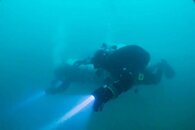I'd mostly plan on freediving off a boat with them....Though we walked off the beach at the BHB Marine park with them, and put them on in chest deep water.....admittedly, there is no surf to speak of here....but I have done plenty of surfa entries in 6 foot surf or bigger when I was younger and stupider

.....the way I would try this in Southern California, provided the bottom is not covered with tons of rocks that you would not want to impact with....would be to walk out a little deeper than knee to thigh deep, have back facing waves, and then slip on the bike shoes.....then fall backwards after a wave with a longer period following, and swim fast in backstroke posture untill deep enough to twist and be face down...as soon as this is accomplished, running under the rest of the waves would be easy enough.....the real issue is how your shore break comes in, and at what depth you can still stand up and put the shoes on....and be able to swim from there....
I don't know how different your 6 foot to 8 foot seas are to ours, in the surf zone....I expect you have larger periods between the waves...which is a little easier for entering....but I know nothing about how smooth the bottom is at the beach sites you would enter from????
p.s.
The $1500 one is for competitions to swim down to new record depths...well over 250 feet deep....the $700ish Dol-Fin versions in the video, are more for freedivers on reefs or scubadivers....




